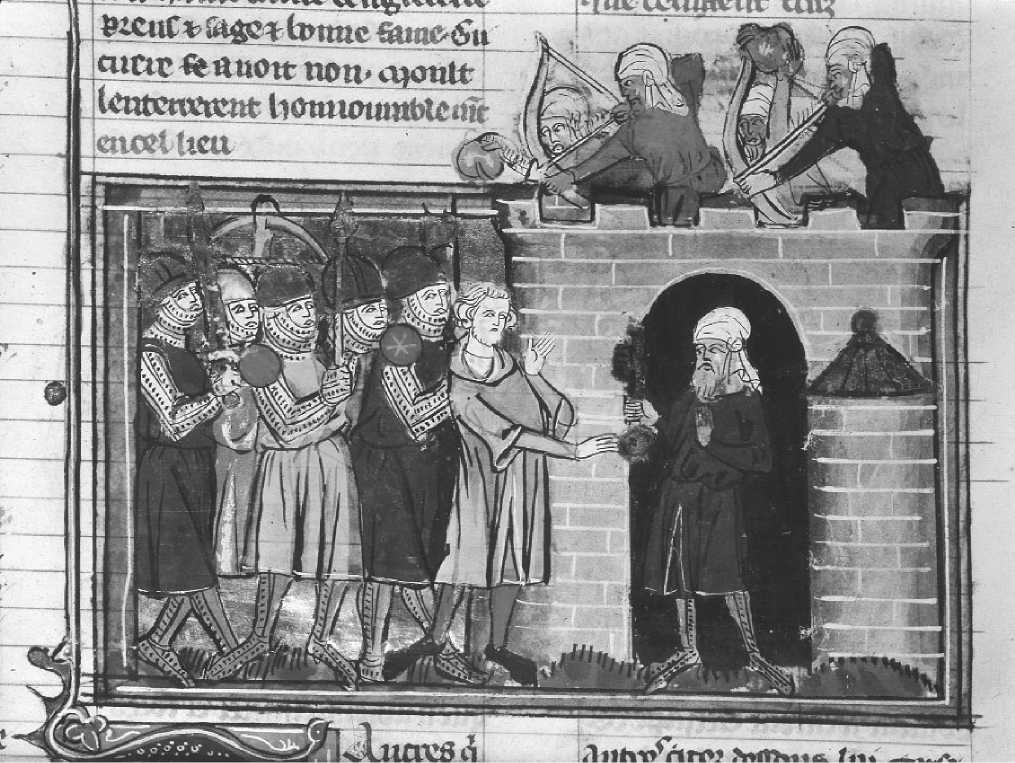Prince of Galilee (1099-1101) and regent of the principality of Antioch (1101-1103 and 1104-1112).

Capture of Tarsos by Tancred during the First Crusade. Illustration from the Roman de Godefroi de Bouillon, MS Paris, Bibliotheque nationale de France, fr.22495, fo. 32v. (1337). (Giraudon/Art Resource)
Tancred was born around 1076, a scion of the Norman dynasty of Hauteville in southern Italy. His parents were Odo “the Good Marquis” and Emma, a daughter of Robert Guis-card, duke of Apulia and Calabria.
In 1096 Tancred joined his maternal uncle, Bohemund of Taranto, in taking part in the First Crusade (1096-1099) and very soon distinguished himself as one of its chieftains, especially in the fighting at Nicaea (mod. Iznik, Turkey) and Dorylaion (near mod. Eskiflehir, Turkey), to the point that his uncle gave him the command of a company of knights. He then penetrated into Cilicia, where he clashed with Baldwin of Boulogne, brother of Godfrey of Bouillon, over the possession of Tarsos (mod. Tarsus, Turkey). Tancred rejoined the main armies at Antioch (mod. Antakya,
Turkey), where he played a significant role in the siege and the conquest of the city. After the establishment of Bohe-mund’s principality at Antioch (1098), Tancred continued toward Jerusalem, joining first Raymond of Saint-Gilles and then Godfrey of Bouillon. Tancred became one of the most important chiefs of Godfrey’s army; in June 1099 he conquered Bethlehem on Godfrey’s behalf and, having joined him at the siege of Jerusalem, he commanded raids to obtain materials for building siege machines and ladders. During the conquest of the Holy City (15 July 1099), he seized the mosques of the Temple Mount and claimed the lordship of the area.
After the establishment of Frankish rule in Jerusalem, Tancred went northward and conquered Tiberias (mod.
Teverya, Israel), Nazareth (mod. Nazerat, Israel), Mount Tabor, and other places in Galilee. He was enfeoffed with these territories by Godfrey of Bouillon. Tancred took the title of prince of Galilee, and by campaigning in the areas of the Golan and the Terre de Suete, he enlarged his principality into the northern Transjordan. In 1100 he commanded the land forces at the siege of Haifa (mod. Hefa, Israel), hoping to secure an outlet for his principality on the Mediterranean. Supported by Daibert of Pisa, the new patriarch of Jerusalem, he took advantage of Godfrey’s death (18 July
1100) to establish his men in Haifa castle. However, these ambitions were checked by Baldwin of Boulogne, Godfrey’s brother, who came from Edessa to become the first Latin king of Jerusalem and appointed Tancred’s rival Geldemar Carpinel as lord of Haifa. The clash between Tancred and King Baldwin I, who had been rivals since their march through Cilicia, was cut short as a result of the capture of Bohemund by the Danishmendid Turks in 1101: Tancred was appointed regent in Antioch and relinquished his Galilean principality to the king.
As regent of Antioch Tancred distinguished himself both militarily, fighting against the Armenians of Cilicia and the Byzantines, who were based in the port of Laodikeia (mod. Al-Ladhiqiyah, Syria), as well as against the Turkish lords of Aleppo and elsewhere in northern Syria, and also as an administrator. After Bohemund’s release in 1103, Tancred became regent of Edessa during the captivity of Count Baldwin II (of Bourcq). Called to Antioch upon Bohemund’s departure to the West in 1104, he became its effective ruler until his death. According to his uncle’s wish, in 1107 he married Cecilia, who was the daughter of King Philip I of France and Bertrada of Montfort and who was then in her childhood.
During the next few years Tancred’s rule in Antioch was uncontested. His combined military and diplomatic talents enabled him to enlarge the principality to the south by annexing Laodikeia, Jabala, and Margat, which connected it with the county of Tripoli, and by establishing a protectorate over Muslim Aleppo. In the dispute over the succession to the county of Tripoli, he supported William-Jordan, cousin of Raymond of Saint-Gilles, in his claims against Bertrand, who was backed by King Baldwin I. In 1108 Baldwin restored Tancred’s title of prince of Galilee and returned to him the ownership of the Temple area of Jerusalem, though the foundation of the abbey of the Temple of the Lord prevented Tancred from exercising any effective authority there.
Tancred’s main activity was concentrated in northern Syria, where the rising power of Mawdud, emir of Mosul, threatened both Antioch and Edessa. Due to the failure of Mawdud’s attack against the Frankish states in 1111, Tancred’s power reached its zenith. He died in the fall of 1112, aged thirty-six years.
Tancred’s personality was complex. A young adventurer, belonging to a cadet branch of his family, he achieved a brilliant career in the crusade and the Latin East. His military and diplomatic skills and immense energy, which were highlighted by his chronicler and admirer Radulph of Caen, were counterbalanced by his hard, self-seeking, faithless, and unscrupulous character; he was unpopular even among his own men. Yet his achievements and prestige became the basis for the growth of his romantic image, to the point that he became a popular hero through the centuries, particularly among the romanticists of the nineteenth century.
-Aryeh Grabois
Bibliography
Murray, Alan V., The Crusader Kingdom of Jerusalem: A Dynastic History, 1099-1125 (Oxford: Prosopographica et Genealogica, 2000).
Mutafian, Claude, “L’enjeu cilicien et les pretensions normandes (1097-1137),” in Autour de la Premiere Croisade: Actes du Colloque de la Society for the Study of the Crusades and the Latin East (Clermont-Ferrand, 22-25juin
1995) , ed. Michel Balard (Paris: Editions de la Sorbonne,
1996) , pp. 453-463.
Nicholson, Robert L., Tancred: A Study of His Career and Work in Their Relation to the First Crusade and the Establishment of the Latin States in Syria and Palestine (Chicago: University of Chicago Press, 1940).
Rheinheimer, Martin, Das Kreuzfahrerfurstentum Galilaa (Frankfurt am Main: Lang, 1990).
Runciman, Steven, A History of the Crusades, vols. 1-2 (Cambridge: Cambridge University Press, 1953).




 World History
World History









